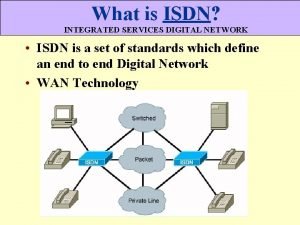Network Switch APPLIED INFORMATION TECHNOLOGY 2016 RHYS GREANEY








- Slides: 8

Network Switch APPLIED INFORMATION TECHNOLOGY 2016 RHYS GREANEY

Switch In a telecommunications network, a switch is a device that channels incoming data from any of multiple input ports to the specific output port that will take the data towards its intended destination.

Set-Up In the traditional circuit-switched telephone network, one or more switches are used to set up a dedicated though temporary connection or circuit for an exchange between two or more parties.

Purpose On an Ethernet Local Area Network (LAN), a switch determines from the physical device (Media Access Control or MAC) address in each incoming message frame which output port to forward it to and out of. In a wide area packet-switch network such as the Internet, a switch determines from the IP address in each packet which output port to use for the next part of its trip to the intended destination. In an Open Systems Interconnection (OSI) communication model, a switch simply looks at each packet or data unit and determines from a physical address (the "MAC address") which device a data unit is intended for and switches it out toward that device.

Unmanaged Switches that in theory should work out of the box. Not designed to be configured, no need to install or set up correctly, will adjust. Less network capabilities than managed switches, usually found in home networking.

Managed Switches This switch is configurable Offers greater flexibility and capacity than unmanaged switches Managed locally or remotely.

Difference between Switch and Router Switch switches within the subnet, that is switching. In switching, packets are transferred from source to its destination using Media Access Control (MAC) address. Switching is done within the network. Whereas Router routes between the network. Routing is a process which is done between two networks using IP addresses.

Typical Example
 The resources need to be reserved during the setup phase in
The resources need to be reserved during the setup phase in Go switch 70 series
Go switch 70 series Al reef institute of logistics and applied technology
Al reef institute of logistics and applied technology Is bilkent university good
Is bilkent university good Applied technology building ball state
Applied technology building ball state Magic quadrant for data masking technology 2016
Magic quadrant for data masking technology 2016 Digital network
Digital network Virtual circuit approach
Virtual circuit approach A switch in a datagram network uses a
A switch in a datagram network uses a















